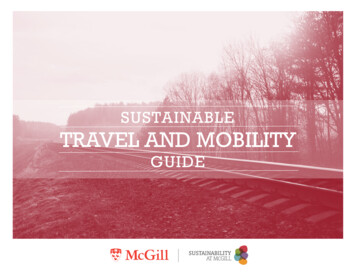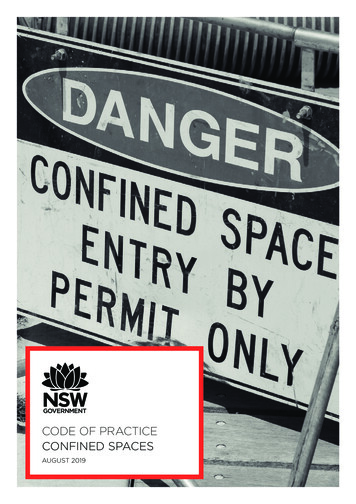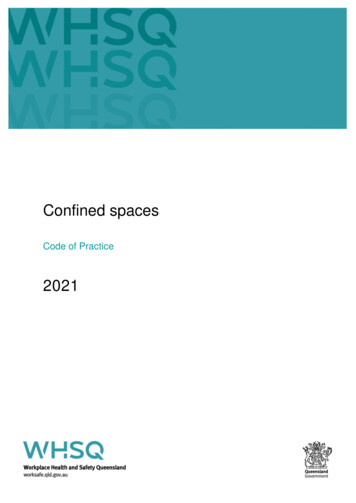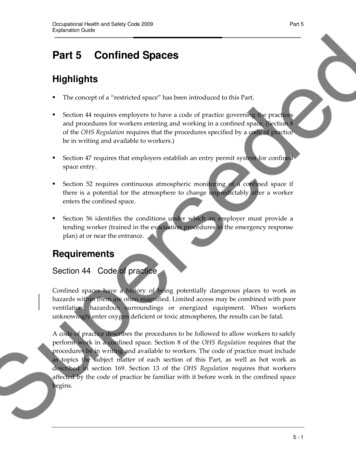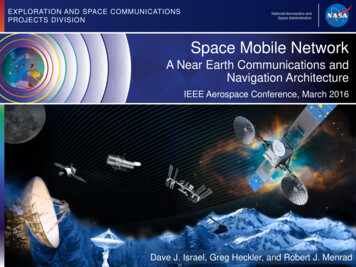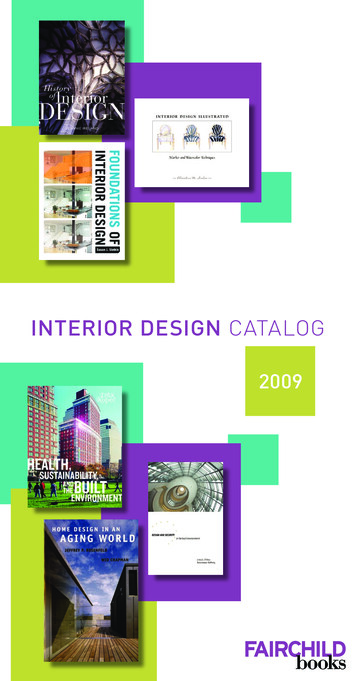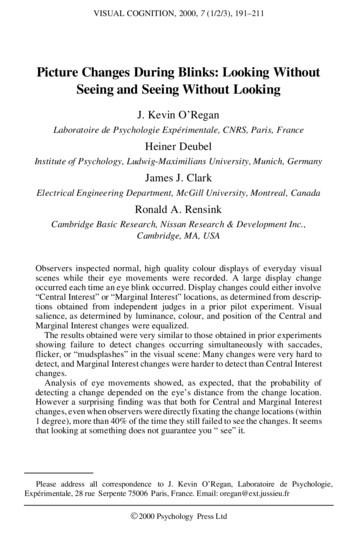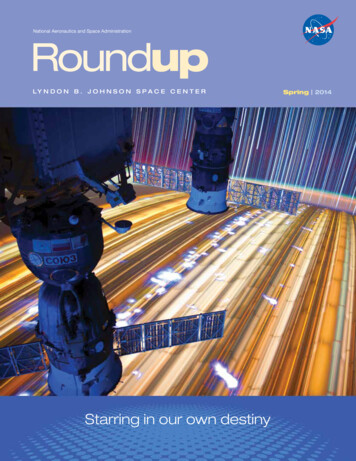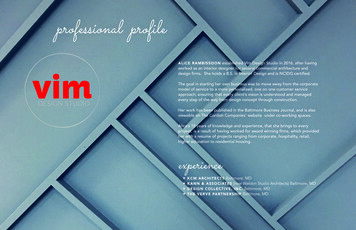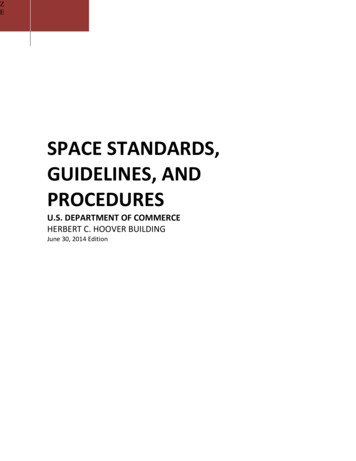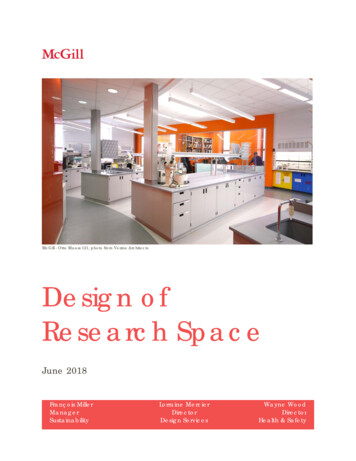
Transcription
McGill - Otto Maass 121, photo from Vezina ArchitectsDesign ofResearch SpaceJune 2018François MillerManagerSustainabilityLorraine MercierDirectorDesign ServicesWayne WoodDirectorHealth & Safety
Table of ContentsI.Introduction . 2II.Consultation Process. 4III.Vision . 5IV.Guiding Principles . 61.Creativity, Innovation & Technology . 62.Planning & Design . 73.Interaction . 84.Health & Safety. 95.Adaptability . 106.Sustainability. 117.Ownership & Governance . 12V.Design criteria . 13VI.Applicability . 21New Construction and Major Renovations . 21Minor Renovations and Improvements . 21VII.Laboratory Design Process . 22VIII. Appendix . 24Appendix 1: Participants . 24Appendix 2: . 25Building Design Standards, Special Building areas Laboratories . 25
IntroductionThis document aims to provide guidance for the Design Process for future research spaces atMcGill. It is written for lab PIs, users, Project Managers, Professionals and Operation & Maintenancepeople, who will execute a lab project from the Initial phase to the end of the project and whowill maintain the spaces after its construction.Photo from Flad Architects, Beyond LEED, Sustainable Laboratory DesignThis guide is directly related to one of the five Principal Susanne Fortier’s priorities, “UnleashingMcGill's Full Research Potential”, and which defines as following:“Today’s research landscape is global, interdisciplinary, focused on excellence, and rooted incollaboration with partners of all types (including industry, non-profits, governments, and otheruniversities). This priority area focuses on laying the foundation for McGill to excel in this increasinglycompetitive and challenging environment.”DESIGN OF RESEARCH SPACES- JUNE 20182
Recognizing the importance of this statement and the constant evolution in every spheres of LabDesign, whether it is regarding lab organization, technologies, sustainability or health & safety,FMAS wishes, by the adoption of this document, to face the future and adopt the best practicesin designing future Research Spaces.From presentation Lab2050 : The Future and Science and Laboratory Spaces, by SmithGroupJJRDESIGN OF RESEARCH SPACES- JUNE 20183
Consultation ProcessThe consultations leading to the Vision, the guiding principles, the design process and thestandards to design research spaces of the future took place from June 28, 2017 to December 14,2017. In total, more than 50 professionals from various sectors participated to the seven meetingsthat were organized. The consultation process was spearheaded by McGill Design services, inclose collaboration with the Office of Sustainability and Environment, Health and Safety.The consultation sessions were meant to address the main design and operational considerationsof the labs of the future, and gather the opinions and feedbacks from professionals who are eitherplanning, using or operating labs at McGill.The seven meetings tackled the following topics: Steering committee – Vision and Guiding principles (June 28, 2017)Maintenance and Operation (October 24, 2017)Sustainability and Energy (November 9, 2017)Architecture (November 15, 2017)Process (November 20, 2017)Health and Safety (December 12, 2017)Lab Users (December 14, 2017)The focus groups of these topics contributed to the overall approach, and had a precious inputon the principles, the process and the standards to design research spaces at McGill.Overview of the consultation processOversight Design ServicesOffice of SustainabilityEnvironment, Health andSafetyVision and GuidingprinciplesSteeringcommitteeDESIGN OF RESEARCH SPACES- JUNE 2018Design andoperationalconsiderations Maintenance andoperationSustainability and energyArchitectureProcessHealth and safetyContentvalidationLab users4
VisionAllen Institute, Perkins Will, photo from archdaily.com“The University research spaces will support collaboration, innovation andfoster creativity with cutting-edge design that is adaptable, safe andsustainable, thus strengthening McGill’s role as a world leading institution”Center for Science and Technology, Chapman University. photo from AC MartinDESIGN OF RESEARCH SPACES- JUNE 20185
Guiding Principles1. Creativity, Innovation & TechnologyThe primary goal of the laboratory remains thesame: Experimentation. However, the path todiscovery, and the way scientists work otics/automation, computer analysis andadvanced communication systems. In arecent Laboratory Equipment reader survey,48percentofrespondentssaidinstrumentation improvements will expandMIT Beaver Works, photo from retaildesignblog.nettheir research capabilities in the next 10 years. The most significant changes in technologiesexpected are likely to be automation systems, data acquisition systems, detectors, and sensors.Stargate 3D printer, photo from Relativity Space360-degree video, photo from Medtronic Applied Innovation LabEmergent technologies will reduce the physical footprint of laboratories and free up time forscientists to engage in more collaborative and idea-based endeavours. The future laboratory willneed to reflect this change, with a choice of working environments replacing the space that waspreviously dedicated to traditional laboratories. The future laboratory will also provide flexibility inthe physical and operational aspects of the laboratory to allow for emergent technologies.Additionally, it will provide collaborative hi-tech tools such as video and virtual conferences toaccommodate a more mobile workforce and supporting mobility, at some level, for all employees.Sensory Immersion Lab atDolby Laboratories,photo from Business WireDESIGN OF RESEARCH SPACES- JUNE 20186
2. Planning & DesignThe ultimate goal of laboratory design is tofoster innovation, support science and keepscientists safe. Laboratories are designed asunits,compartmentalized,self-containedand not collectively. Scientists are separatedfrom each other in formally arranged andrigid layouts, reflecting linear processes andstatic functionality.The nature of laboratory work requiresMolecular biologydistinct workspaces, and a defined, butPhoto from Payetteresearch module,permeable barrier between them. Scientistsworking in these spaces need an area that allows for both focusedconcentration and easyengagement with colleagues. Design should use acoustictechnologies and visualcuestobringthesedifferent spaces as closetogetheraspossible.Adjacencies and visualconnections should becreatedtoallowforspontaneous gn should focus onworkplacesthatpromote innovation, thePhoto from CO architectstransfer of knowledge, collaboration and effectiveness while stillprovidingenvironment which is desirable to occupy. Another considerationto take into account isabeautifulthe integration of flexible laboratories that would allow rapid reconfiguration based on scientificneeds.Actual Space AllocationA study done in 2014 byOthers,25%CBRE, demonstrated that a“typical” laboratory in lifeCollaboration, 7%Wet LabSpace, 49%science industry devotesonly 7% of its square footagefor collaboration with almostno dedicated space forTechnology, 19%DESIGN OF RESEARCH SPACES- JUNE 2018thinking and contemplation.(Source: CBRE Life SciencePractice)7
3. InteractionChallenging researchers to collaborate across disciplines, despite their initial reluctance, has ledto the creation of new fields of study not defined 20 years ago.Interdisciplinary collaboration has become paramount to academic and corporate-basedresearch. Fixed benches and utilities limit scientists to their individual workstation and hinder themfrom working in teams.Francis Crick Institute, HOK architects, photo by Paul GrundyThe sharing of personnel (and equipment) mayprove to be a highly effective measure to counterrealities such as budget restrictions.Collaboration spaces, venues and pathways forchance meetings are seen as critically importantmeans to foster an innovative culture. A variety ofmeeting rooms with video conferencing, informalsocial/working areas with a place for laptops,whiteboards on every surface and glass walls arethe norm. Design efforts will look to the creationof spaces that promote collaboration acrossmore disciplines and further multidisciplinary DesignthatwillalsocreatetheMcGill - Mac Eng lab, photo from Vezina architectsopportunity to allow mixing of users from multiplelocations based on synergies between groupsaround an area of study, as opposed to within aspecific discipline. Other design considerationsinclude the possibility to provide open spacescreating more visual connections, the use oftechnology to untether and connect people andthe integration of virtual communication.DESIGN OF RESEARCH SPACES- JUNE 2018Photo from Electronic Visualization Laboratory8
4. Health & SafetyHealth and safety means, first and foremost,protecting the health and safety of ourcommunity and guests and fostering oaresearchenvironment. It also encompasses protectionfrom material losses or events that cannegativelyimpactonthecontinuedoperation of the institution. Compliance withhealth and safety legislations is a complexchallenge, with jurisdictions at the municipal,provincial, national and international levels.Research granting agencies also imposeOverhead Utility Connections, photo from presentation by Jameshealth and safety conditions as a part of theSchreyer, From Afterthought to Forethought: Designing an Optimalresearch granting process. Health and safetyAnalytical labis a moving target, with new hazards emerging from new research, coupled with a steady streamof new regulatory requirements.Meeting the compliance requirements of health and safetyin the research lab is commonly viewed as an obstacle toprogress, however the ultimate goal is not to put upobstacles, rather it is to effectively manage risks and avertsituations which can impede progress. The aim in the labdesign process is to make sure the safety components are“right-sized” i.e., able to meet the demands of the presentand flexible enough to also do so in the future. On one hand,an under-designed lab can result in retrofits that usually costmore than they would have if included in the original design,while on the other hand, and an over-designed lab caninclude expensive safety features that are never used,thereby diverting valuable financial resources that couldhave been used on more important items.Safety shower & eye wash, photo from presentationby James Schreyer, From Afterthought toForethought: Designing an Optimal Analytical labDESIGN OF RESEARCH SPACES- JUNE 20189
5. AdaptabilityFlexible furniture with overhead service carriers, photo from Waldner Laboratory SystemsScience and technology change rapidly, and the facilities used for them do too. Therefore, newlaboratory must be flexible and adaptable. Maximizing adaptability has always been a keyconcern in designing or renovating a laboratory building. Adaptability can mean several things,including the ability to expand easily, to readily accommodate reconfigurations and otherchanges, and to permit a variety of uses.Adaptable labs allow universities to meet changingneeds in the future while reducing renovation costs and lab downtime. Core facilities and campusamenities are resources which enable flexibility and adaptability in general research space. Theystrengthen the campus community and foster the exchange of ideas by serving differentdepartments, which may not have otherwise interacted. Adaptability features allow lab space tobe leaner and increase efficiencies in layout.Adaptable labfurniture, photofrom NewEngland LabDESIGN OF RESEARCH SPACES- JUNE 201810
6. SustainabilitySustainability means meeting our own needs without compromising the ability of futuregenerations to meet their own needs. In addition to natural resources, we also need social andeconomic resources. Sustainability is not just environmentalism. Embedded in most definitions ofsustainability we also find concerns for social equity and economic development. In the contextof a lab, it means developing new approaches (technical, operational and behavioral) toenhance the environmental performance of a space that feels safe, inclusive and connected,with a sounds economic approach.Tufts University Science and Engineering Complex, photo by PayetteLaboratories are places of discovery and scientificPhoto from labconco.comprogress,housingboththeresearch that matters and the researchers, andequipment responsible for it. All thatscience, though, takes energy, and many facilities—especiallyventilation needs—utilize it in high volumes. Tocombat this issue, it is important tothosewithsignificantimplement strategies in the workplace that willminimize the environmental footprintof our labs and make them environmentally friendlyhomes for the science of tomorrow.In a lab that embodies the principle of sustainability,people collaborate across disciplinesto inform and advance solutions to contemporaryproblems. They are aware of andresponsible for the environmental, economic andsocial implications of their research.The Well Living Lab,photo from DelosVentures and MayoClinicDESIGN OF RESEARCH SPACES- JUNE 201811
7. Ownership & GovernanceIn a large institution where responsibilities are widely dispersed the question of ownership is asubject of ongoing debate. Who actually owns a lab? The PI, the department, the faculty, andcentral administration can all lay claim to ownership in some respects, but who is responsible forthe space allocation, the design, construction, and choice of materials; the operation of the laband its maintenance.What about safety surveillance, emergency preparedness, and theresponsibility for reporting and correcting problems? When does a deficiency become an extra?Whopays?OICR’s Research Laboratory, Diamond Schmitt Architects, photo from architecturelab.netOwnership of laboratories, responsibility for maintaining them and accountability for what goeson inside the laboratory should be clearly defined and well understood by all stakeholders. Newlaboratories do not always requirenew space if existing spaces eallocated on the basis of the needsof the University, irrespective ofinter-departmental or inter-facultydifferences over ownership. This linaryresearch.OICR’s Research Laboratory, Diamond Schmitt Architects, photo fromarchitecturelab.netDESIGN OF RESEARCH SPACES- JUNE 201812
Design criteriaA survey was conducted December 12th 2017 through January 10th 2018 to gather input from labusers regarding laboratory design.In total, 87 responses were received from users with various functions in various fields of #userAcademic associate1Academic staff19Cognitive Neuroscience2Assistant professorFood Science & Agricultural Chemistry1Associate professorBuilding Management1Building director1Human Genetics2Chair1IPN3Chief research technician1Kinesiology & Physical Education7Course technician1Integrative Neuroscience1Engineer1Medicine3Grad student6Microbiology & Immunology4Lab coordinator2MNI8Lab manager2Natural Resource Science1Lab technician2Neurology & logy1Postdoc3Pathology1Professor10Pharmacology & Therapeutics1Program manager1Physics6Project officer1Physiology2Research assistant9Plant Science1Research associate5Psychology4Researcher1Redpath Museum3Technical assistant2Questions were asked about general laboratory design, open lab concept, sharing of spaces andequipment, safety issues, collaboration, technologies, flexibility of lab layout and furniture, storage,space types, aesthetics and sustainability.DESIGN OF RESEARCH SPACES- JUNE 201813
The primary criteria in laboratory design according to the users’ opinion is functionality. Anappropriate layout respecting the laboratory’s needs can allow for a smooth work-flow dynamicbetween users, ensuring at the same time an efficient use of space and an adequate level ofsafety.According to you, what is the most important element toconsider in laboratory design?material1%collaboration1%comfort1%enough dows1%0%10%20%What do you think of the openlab concept where laboratoryspace is shared betweenmany users?neutral2%30%hesitant41%50%60%When asked about the open lab concept, 41%of the users were hesitant. They have indicatedthat the following requirements would have tobe fulfilled in order for open lab concept towork: es(cleaning, schedule, access) Fair sharing of equipment costs, materialcosts, maintenance and operation costs Mutual trust and respect between users Proper layout for convenient access ipmentnonandexperiments, independent work space andnegative22%personal storageThe complexity of achieving these same requirements were why 22% of the users believe that anopen lab concept cannot work. In addition, they believe that open labs can hinder concentration,have inadequate acoustics, and lack confidentiality for certain labs.DESIGN OF RESEARCH SPACES- JUNE 201814
Would you be willing to shareequipment with othercolleagues/ departments?Equipment users are willing to share: Low-usage equipment Expensive equipment Common equipment100%90% Large equipment80% Core facility equipment Equipment not requiring personalized setup70%60%Some sharable equipment listed by the50%users: centrifuge, ice machine, autoclave,40%shaker, balance, fume hood, BSC-hood, drying30%oven,20%computer, microscope, flow cytometer, printer,10%motion caption system, imaging software,0%yesnofridge,robot,machine, gel imaging, etc.Would you be willing to sharespace with other colleagues/departments? Lab space Bench space Equipment room Storage room Meeting / conference room Student space60% Office space Kitchen / lounge50%80%70%40%52% of the users had safety concerns regarding30%open labs. These concerns are mostly focused20%on human behavior.10%In general, the users are worried about thedisrespectfreezer,spectrophotometer, PH meter, dishwashingSpaces users are willing to onegligence, unauthorized use, the lack of communication, and the lack of accountability. Othersafety issues raised are on waste management, spill containment, and possible contamination.Proper safety training are therefore compulsory for everyone who will be using the shared spacesand the shared equipment in the open lab setting.Certain equipment or experiments with high security protocols may therefore be inadequate inan open lab setting, such as lasers, animal allergens, and radioactivity.DESIGN OF RESEARCH SPACES- JUNE 201815
An effort should be made in lab design to provide collaboration spaces to allow lab users toexchange ideas and encourage interaction that can lead to innovation.How important is it for youto be able to collaboratewith other colleagues?How important is it for youto be able to collaboratewith other departments?Very importantSomewhat importantVery importantSomewhat importantNot importantNeutralNot importantNeutral2%10%17%32%5%28%60%46%A proper balance should be provided between collaboration spaces for small and large groups,and quiet spaces for individual reflection and writing.In order of priority, which of the following types of spacewould you like to have (or have more of) near your lab?Quiet space for reflection and writingSmall group discussionLarge group discussion70%60%50%40%30%20%10%0%First choiceSecond choiceThird choiceNot neededAccording to the survey results, there are significant needs for quiet individual workspaces andbreak-out spaces for small group discussions. This requirement should therefore be taken intoconsideration when planning research spaces.DESIGN OF RESEARCH SPACES- JUNE 201816
Since laboratory furniture and storage occupy a large footprint in many laboratories, users wereasked to grade the level of importance of these elements in their lab spaces.How important is it for you to have storage space in or nearyour lab?How important is it for you to be able to adjust the height of thelab furniture?How important is it for you to have the flexibility to reconfigureyour lab space easily if/when needed?NeutralNot importantSomewhat importantVery important0%10%20%The results indicate that storage isprimordial, and it would be best ifstorage spaces can be in proximity of30%40%50%60%70%80%90%Is storage space useful to you ifit is not in or near your lab?the lab spaces.Flexibilityandadaptabilityofthelaboratory furniture are also important.Being able to adjust the height and the29%36%noconfiguration of the furniture easily andMaybequickly according to the users’ needsshould be considered a basic feature ofYes36%the laboratory of tomorrow.DESIGN OF RESEARCH SPACES- JUNE 201817
In your opinion, howimportant is the capacity tointegrate emergenttechnologies in lab spacedesign?Very important13%1%26%60%Most laboratories are heavily technologyfocused. As technology advances, 86% of theusers agree that laboratory design should takeinto consideration the capacity to adapt andintegrate these emergent technologies.At the same time, as workforce has becomeincreasingly more mobile, lab users do notSomewhatimportantnecessarily have to be physically inside their labNot importantof the users responded that being able toNeutralspaces to perform or monitor experiments. 75%connect to their lab remotely is somewhatimportant to very important.The kind of information that users would like toHow important is it for youto be able to connectremotely to your lab?access remotely are: Computer data Cloud storage for data / data saved onVery importanta lab server Data recording and filing Monitor long term experiments Experiment results Lab status (Temperature/humidity) Equipment status Remote control of equipment Space booking system Online lab tools Software, computer programs Inventory lists Schedules for equipment use Real-time monitor of who is using14%Somewhatimportant38%11%Not important37%46%Neutral51%36%24%the equipment (log-in’s) 17% 15%Communication to other lab ortant3%NotimportantNeutralHow important are aesthetics in your appreciation of lab space?How important is it to you that sustainability elements be integrated intolab space design?DESIGN OF RESEARCH SPACES- JUNE 201818
Finally, we asked the users to elaborate, based on their previous lab renovation and constructionprojects, on the most important oversights to avoid: Lack of communication between Design team and users. Design has to be consulted withall the users, including TAs and lab coordinators Lack of basic supplies (vacuum, CO2, network, air conditioning) Not sufficient power (variety and number of electrical and data outlets) Interference with lab research (downtime and disturbance to adjacent spaces) Low ceiling height, inadequate circulation space, lack of natural lighting Inadequate separation of student offices from PI offices (hamper productivity) Inadequate acoustics for offices Loud and inadequate HVAC system Lack of space for equipment room, storage, meeting space, and lunch room Lack of functionality and flexibility Lack of appropriate equipment Bad quality of materialConclusionIn conclusion, in order to have a proper laboratory design, it is important to involve keystakeholders such as the lab users throughout the design process. Since a lab has generic areasthat can be common with other labs, but also function-specific areas that are unique to it, an indepth needs analysis is required at the early stage of Design.At this needs analysis, key questions to ask would be regarding infrastructure requirements andalso space requirements in order to achieve functionality and flexibility.Design criteria such as aesthetics, quality of material, quality of space, and access to natural lightshould be inherent to all design.Other design criteria and objectivesIn addition to the criteria mentioned in the survey, during the different focus group sessions, variouskey design elements were raised (some of which are already listed in the survey). These designelements should be taken in consideration whenever possible in the planning of new labs or in therenovation or redesign of existing labs. Promote the international reputation Place Human at the center of the project Ally “WELL” principles for the well-being of the users Use materials with a beneficial life cycle Plan for Universal Access Apply ergonomic principlesDESIGN OF RESEARCH SPACES- JUNE 201819
Biofilia: Bring in nature, promote connection with nature Install vegetable walls (plants, natural colors, water elements) Plan for users and not for the equipment. Privilege the use of windows for users. Promote Visibility, views of outside Plan for low stress, safe & social spaces, noise control, privacy, art Plan for resource sharing. This should become interdepartmental (property management) Plan for management of residual materials, spaces for garbage cans, bins etc., Considerflow analysis and sorting at source Plan for data management: centralize servers (Burnside) or elsewhere, heat recovery (OttoMaass), redundancy, promote "virtual machines" Spatial planning General orientation: avoid closed rooms along windows, favor high occupancy rate,shared spaces. Glass wall, transparency, and light breakthroughs, light impact analysis,light wells, fiber optic applications. Traffic flow: research process to understand Place offices near laboratories, plan for universally accessible technical corridor,subsidized collaborative common spaces of central offices. Building Dashboard Exhaust and ventilation Commissioning Promote sustainability : zero waste, safe Promote adaptability : flexible, transformative, accessibility, inclusive, evolving, mobile,design for all, modularity Consider human factors: living spaces, social spaces, human focused, inclusive, healthyspaces, ergonomic Consider community factors: interactive, interdisciplinary, innovative, build aroundcommunity Ownership Potential energy saving: freezers, fridges, autoclaves, glassware washing, etc. Meeting places team based labs: open spaces, visual connection, co-beneficial forstudents with mental health issues, meeting rooms, natural light, pleasant place, kitchennot in circulation, comfortable furniture, writing and display surface, natural light. Acoustictransparency, maintained inside the lab, shared spaces. Collaboration space.Confidentiality elements to respect. Conference rooms. Flexibility, modularity, mobile case-work ( anti-slip floor, researchers are replaced often) Modulate the furniture according to the needs, flexibility in the infrastructure, equipmentzone. Mixture of furniture type: Generic: fixed - sink – hood and Specialized: modular.Modular equipment room 100%. Storage space for furniture to reuse. Include proper lighting controls: task lighting reduce lighting density Install proper lab exhaust: containment, hoods at the lowest possible flow, analysis system Consider the use of chilled beams : heavy infrastructure, advantage for new building Design all basic BSL2 labsDESIGN OF RESEARCH SPACES- JUNE 201820
ApplicabilityIn order to assist the Design team in the vetting of future labs process goals and objectives, McGillhas identified two levels of design requirements for projects based on their scope of work.New Construction and Major RenovationsFor all new building or building-wide, full-gut renovation projects (more than 50% of thebuilding spaces), or for all fit-outs and partial building interior fit-outs of more than 250 m²and/or 10 people and of at least one building story and multiple building systems, the GuidingPrinciples, the Building Design Standards for laboratories and the Design Process shall
Stargate 3D printer, photo from Relativity Space 360-degree video, photo from Medtronic Applied Innovation Lab Sensory Immersion Lab at Dolby Laboratories, photo from Business Wire . DESIGN OF RESEARCH SPACES- JUNE 2018 7 2. Planning
